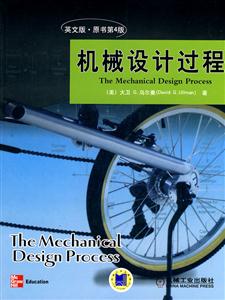-
>
湖南省志(1978-2002)?铁路志
-
>
公路车宝典(ZINN的公路车维修与保养秘籍)
-
>
晶体管电路设计(下)
-
>
无头案:雍正暴亡之谜
-
>
基于个性化设计策略的智能交通系统关键技术
-
>
花样百出:贵州少数民族图案填色
-
>
识木:全球220种木材图鉴
机械设计过程(英文版 原书第4版) 版权信息
- ISBN:9787111299011
- 条形码:9787111299011 ; 978-7-111-29901-1
- 装帧:暂无
- 册数:暂无
- 重量:暂无
- 所属分类:>>
机械设计过程(英文版 原书第4版) 本书特色
《机械设计过程(英文版·原书第4版)》由机械工业出版社出版。
机械设计过程(英文版 原书第4版) 内容简介
本书明确提出了“产品设计”的设计技术,是针对产品设计的设计思想,理论.技术和方法,而对于那些针对“机构”和“零件结构”的设计技术,只作为基础知识介绍。
本书全面、具体地给出了“设计学”的基本内容,详细地引出了设计的典型步骤,每一个步骤的任务、目标,应考虑的主要问题和常用的解决方法,对产品设计具有很好的指导作用。
机械设计过程(英文版 原书第4版) 目录
序
preface
chapter 1 why study the design process?
1.1 introduction
1.2 measuring the design process with product cost, quality, and time to market
1.3 the history of the design process
1.4 the life of a product
1.5 the many solutions for design problems
1.6 the basic actions of problem solving
1.7 knowledge and learning during design
1.8 design for sustainability
chapter 2 understanding mechanical design
2.1 introduction
2.2 importance of product function, behavior, and performance
2.3 mechanical design languages and abstraction
2.4 different types of mechanical design problems
2.5 constraints, goals, and design decisions
2.6 product decomposition
chapter 3 designers and design teams
3.1 introduction
3.2 the individual designer: a model of human information processing
3.3 mental processes that occur during design
3.4 characteristics of creators
3.5 the structure of design teams
3.6 building design team performance
chapter 4 the design process and product discovery
4.1 introduction
4.2 overview of the design process
4.3 designing quality into products
4.4 product discovery
4.5 choosing a project
chapter 5 planning for design
5.1 introduction
5.2 types of project plans
5.3 planning for deliverables the development of information
5.4 building a plan
5.5 design plan examples
5.6 communication during the design process
chapter 6 understanding the problem and the development of
engineering specifications
6.1 introduction
6.2 step 1: identify the customers: who are they?
6.3 step 2: determine the customers' requirements: what do the customers want?
6.4 step 3: determine relative importance of the requirements: who versus what
6.5 step 4: identify and evaluate the competition: how satisfied are the customers now ?
6.6 step 5: generate engineering specifications: how will the customers' requirement be met?
6.7 step 6: relate customers' requirements to engineering specifications: how to measure what?
6.8 step 7: set engineering specification targets and importance: how much is good enough?
6.9 step 8: identify relationships between engineering specifications: how are the hows dependent on each other?
6.10 further comments on qfd
chapter 7 concept generation
7.1 introduction
7.2 understanding the function of existing devices
7.3 a technique for designing with function
7.4 basic methods of generating concepts
7.5 patents as a source of ideas
7.6 using contradictions to generate ideas
7.7 the theory of inventive machines, triz
7.8 other important concerns during concept generation
chapter 8 concept evaluation and selection
8.1 introduction
8.2 concept evaluation information
8.3 feasibility evaluations
8.4 technology readiness
8.5 the decision matrix--pugh's method
8.6 product, project, and decision risk
8.7 robust decision making
chapter 9 product generation
9.1 introduction
9.2 boms
9.3 form generation
9.4 materials and process selection
9.5 vendor development
9.6 generating a suspension design for the matin 2008 mount vision pro bicycle
chapter 10 product evaluation for performance and the effects of variation
10.1 introduction
10.2 monitoring functional change
10.3 the goals of performance evaluation
10.4 trade-off management
10.5 accuracy, variation, and noise
10.6 modeling for performance evaluation
10.7 tolerance analysis
10.8 sensitivity analysis
10.9 robust design by analysis
10.10 robust design through testing
chapter 11 product evaluation: design for cost, manufacture,assembly, and other measures
11.1 introduction
11.2 dfc--design for cost
11.3 dfv design for value
11.4 dfm--design for manufactur
机械设计过程(英文版 原书第4版) 节选
《机械设计过程(英文版·原书第4版)》明确提出了“产品设计”的设计技术,是针对产品设计的设计思想,理论.技术和方法,而对于那些针对“机构”和“零件结构”的设计技术,只作为基础知识介绍。《机械设计过程(英文版 原书第4版)》全面、具体地给出了“设计学”的基本内容,详细地引出了设计的典型步骤,每一个步骤的任务、目标,应考虑的主要问题和常用的解决方法,对产品设计具有很好的指导作用。
- >
小考拉的故事-套装共3册
小考拉的故事-套装共3册
¥20.4¥68.0 - >
罗曼·罗兰读书随笔-精装
罗曼·罗兰读书随笔-精装
¥40.6¥58.0 - >
中国人在乌苏里边疆区:历史与人类学概述
中国人在乌苏里边疆区:历史与人类学概述
¥24.0¥48.0 - >
人文阅读与收藏·良友文学丛书:一天的工作
人文阅读与收藏·良友文学丛书:一天的工作
¥16.0¥45.8 - >
苦雨斋序跋文-周作人自编集
苦雨斋序跋文-周作人自编集
¥6.9¥16.0 - >
山海经
山海经
¥21.8¥68.0 - >
李白与唐代文化
李白与唐代文化
¥9.5¥29.8 - >
朝闻道
朝闻道
¥10.2¥23.8
-
机械设计手册 机器人与机器人装备
¥42.2¥48 -
2022图书×抽奖盲袋
¥9.9¥25 -
2023读书月阅读盲盒——天黑,闭眼,刀谁?
¥42.3¥158 -
2022读者节纪念徽章-三星会员专属
¥45¥45.6 -
2023读书月阅读盲盒——我什么场面没见过?
¥42.3¥158















